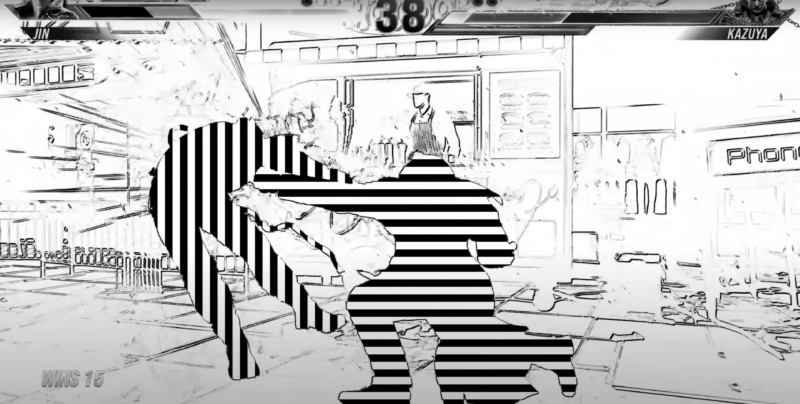

One of Tekken 8’s “colorblind” modes is causing migraines, vertigo, and debate
source link: https://arstechnica.com/gaming/2024/01/tekken-8s-colorblind-mode-is-causing-migraines-vertigo-and-debate/
Go to the source link to view the article. You can view the picture content, updated content and better typesetting reading experience. If the link is broken, please click the button below to view the snapshot at that time.
A striking game —
One of Tekken 8’s “colorblind” modes is causing migraines, vertigo, and debate
Advocates say the intention is good, but the application is dangerous.
Kevin Purdy - Updated 1/2/2024, 8:14 PM

Modern fighting games have come quite a long way from their origins in providing accessibility options. Street Fighter 6has audio cues that can convey distance, height, health, and other crucial data to visually impaired players. King of Fighters 15 allows for setting the contrast levels between player characters and background. Competitors like BrolyLegs and numerous hardware hackers have taken the seemingly inhospitable genre even further.
Tekken 8, due later this month, seems to aim even higher, offering a number of color vision options in its settings. This includes a stark option, with black-and-white and detail-diminished backgrounds and characters' flattened shapes filled in with either horizontal or vertical striped lines. But what started out as excitement in the fighting game and accessibility communities about expanded offerings has shifted into warnings about the potential for migraines, vertigo, or even seizures.
You can see the mode in action in the Windows demo or in a YouTube video shared by Gatterall—which, of course, you should not view if you believe yourself susceptible to issues with strobing images. Gatterall's enthusiasm for Tekken 8's take on colorblind accessibility ("Literally no game has done this") drew comment from Katsuhiro Harada, head of the Tekken games for developer and publisher Bandai Namco, on X (formerly Twitter). Harada stated that he had developed and tested "an accessibility version" of Tekken 7, which was never shipped or sold. Harada states that those "studies" made it into Tekken 8.
A stark black-and-white mode is, as emphasized by commenter OOPMan, only one of Tekken 8's colorblind-minded accessibility options. The game, in its current demo form, offers modes for blue, red, and green blindness, for adding patterns to player characters, and adjustments for the stage and characters. But the inclusion of the striking filters, in any circumstances, drew criticism.
AdvertisementMorgan Baker, game-accessibility lead at Electronic Arts, asked followers to "Please stop tagging me in the Tekken 8 'colorblind' stripe filters." The scenes had "already induced an aura migraine," Baker wrote, and she could not "afford to get another one right now."
Accessibility consultant Ian Hamilton reposted a number of people citing migraines, nausea, or seizure concerns while also decrying the general nature of colorblind "filters" as an engineering-based approach to a broader design challenge. He added in the thread that shipping a game that contained a potentially seizure-inducing mode could result in people inadvertently discovering their susceptibility, similar to an infamous 1997 episode of the Pokémon TV series. Baker and Hamilton also noted problems with such videos automatically playing on sites like X/Twitter.
James Berg, accessibility project manager at Xbox Game Studios, went further into explaining why moving solid lines on a video might cause issues for people affected by strobing. "Patterns of lines moving on a screen creates a contiguous area of high-frequency flashing, like an invisible strobe," Berg wrote. "Human meat-motors aren't big fans of that." At a certain point, typically around 40 frames per second, people start to experience "flicker fusion frequency," though some people can experience it at 60 fps (or Hz).
Tekken's Harada pushed back, writing later, "A few people, albeit very few," misunderstood what his team was trying to do. There are multiple options, not just one colorblind mode, Harada wrote, along with brightness adjustments for effects and other elements. "These color vision options are a rare part of the fighting game genre, but they are still being researched and we intend to expand on them in the future," Harada wrote. He added that developers "have been working with several research institutes and communities to develop this option," even before the unsold "accessibility version of Tekken 7."
Awareness of color blindness has come a long way from being a rare afterthought, and accessibility in games has grown along with the industry, if still requiring advocacy. Developers are discovering audiences they might never have imagined, like blind EA sports players. And a general awareness of accessibility needs, and the large market that can be tapped when they are addressed, has pushed many games toward inclusiveness. Yet there are, it seems, many more lessons to be learned for new and established developers.
Recommend
About Joyk
Aggregate valuable and interesting links.
Joyk means Joy of geeK